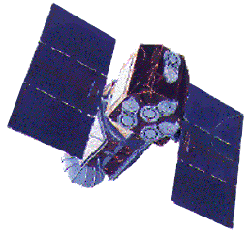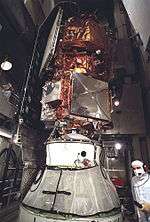Extreme Ultraviolet Explorer
 The EUVE spacecraft | |||||
| Names | Explorer 67 | ||||
|---|---|---|---|---|---|
| Mission type | Ultraviolet astronomy | ||||
| Operator | NASA | ||||
| COSPAR ID | 1992-031A | ||||
| SATCAT № | 21987 | ||||
| Website |
ssl | ||||
| Mission duration | 9 years | ||||
| Spacecraft properties | |||||
| Bus | Multimission Modular Spacecraft | ||||
| Manufacturer | Berkley University SSL | ||||
| Dry mass | 3,275 kilograms (7,220 lb) | ||||
| Start of mission | |||||
| Launch date | June 7, 1992, 16:40:00 UTC | ||||
| Rocket | Delta 6920-X[1] | ||||
| Launch site | Cape Canaveral LC-17A[1] | ||||
| End of mission | |||||
| Disposal | deactivated | ||||
| Deactivated | 31 January 2001 | ||||
| Decay date | 30 January 2002 | ||||
| Orbital parameters | |||||
| Reference system | Geocentric | ||||
| Regime | Low Earth | ||||
| Eccentricity | 0.01152 | ||||
| Perigee | 515 kilometers (320 mi) | ||||
| Apogee | 527 kilometers (327 mi) | ||||
| Inclination | 28.4 degrees | ||||
| Period | 94.8 minutes | ||||
| Epoch | 11 July 1992[2] | ||||
| Main telescope | |||||
| Type | Wolter telescope | ||||
| Wavelengths | Ultraviolet (7-76 nm) | ||||
| |||||
The Extreme Ultraviolet Explorer (EUVE) was a space telescope for ultraviolet astronomy, launched on June 7, 1992. With instruments for ultraviolet (UV) radiation between wavelengths of 7 and 76 nm, the EUVE was the first satellite mission especially for the short-wave ultraviolet range. The satellite compiled an all-sky survey of 801 astronomical targets before being decommissioned on January 31, 2001. It re-entered the atmosphere on January 30, 2002.[3]
Mission goals
The goals of the mission included several different areas of observation using the extreme ultraviolet (EUV) range of frequencies:
- To make an all-sky survey in the extreme ultraviolet band
- To make a deep survey in the EUV range on two separate bandpasses
- To make spectroscopic observations of targets found by other missions
- To observe EUV sources such as hot white dwarfs and coronal stars
- To study the composition of the interstellar medium using EUV spectroscopy
- To determine whether it would be beneficial to create another, more sensitive EUV telescope

The Extreme Ultraviolet Explorer Spacecraft prior to launch
Payload instruments
NASA describe these:[4]
- 2 Wolter-Schwarzschild Type I grazing incidence mirror, each with an imaging microchannel plate (MCP detector)(Scanner A & B) FOV ~5° diameter; two passbands 44-220 Å 140-360 Å
- 1 Wolter-Schwarzschild Type II grazing incidence mirror, with an imaging microchannel plate (MCP detector) FOV ~4° diameter; two passbands 520-750 Å 400-600 Å
- 1 Wolter-Schwarzschild Type II grazing incidence mirror Deep Survey/Spectrometer Telescope. The light is split, with half of the light fed to:
- An imaging Deep Survey MCP detector [and the other half to ]
- Three Spectrometers which are each combinations of a grating and MCP detector: SW (70-190 Å) MW (140-380 Å) LW (280-760 Å).
See also
References
- 1 2 "EUVE". Encyclopedia Astronautica. Retrieved 18 July 2013.
- ↑ McDowell, Jonathan. "Satellite Catalog". Jonathan's Space Page. Retrieved 18 July 2013.
- ↑ "EUVE spacecraft re-enters Earth's atmosphere" (Press release). NASA. January 31, 2002.
- ↑ http://heasarc.gsfc.nasa.gov/docs/euve/euve.html
External links
- National Space Science Data Center site on EUVE
- EUVE page at Space Sciences Lab (links to science highlights and publications)
- EUVE page at NASA-GSFC
- EUVE page at NASA-STScI (MAST) (has stellar map of EUVE observations)
This article is issued from Wikipedia - version of the 7/21/2015. The text is available under the Creative Commons Attribution/Share Alike but additional terms may apply for the media files.